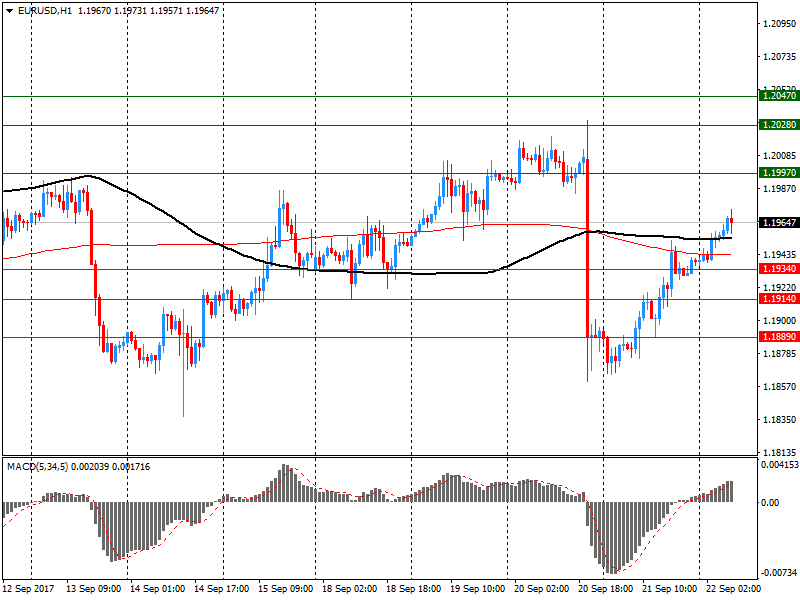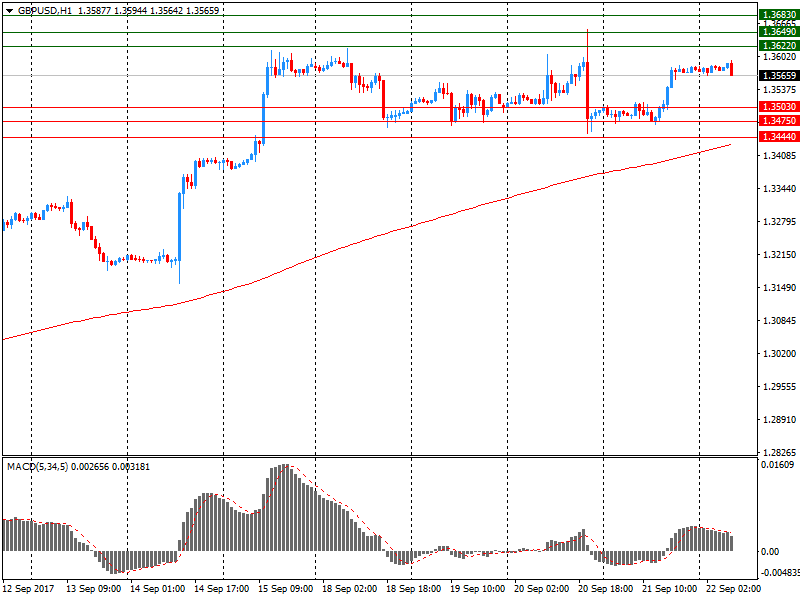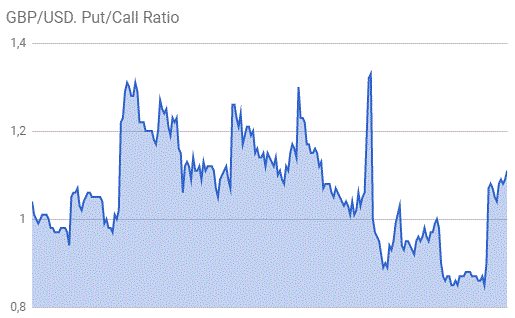Market news
-
17:01
U.S.: Baker Hughes Oil Rig Count, September 744
-
14:40
UK PM May: We will honour commitments to EU that we have made during period of membership
-
13:57
September data revealed a strong increase in U.S. private sector business activity - Markit
September data revealed a strong increase in U.S. private sector business activity, with the rate of growth close to August's seven-month peak. The latest expansion of private sector output was driven by a robust upturn in services activity, which contrasted with relatively subdued growth among manufacturing companies.
At 54.6 in September, the seasonally adjusted IHS Markit Flash U.S. Composite PMI Output Index was down slightly from 55.3 in August but still comfortably above the 50.0 no-change value. Higher levels of private sector output have been recorded in each month since March 2016.
-
13:56
UK PM May says we are moving through a new and critical period in UK-EU relationship
-
13:54
Sterling hits day's low of $1.3526 as UK PM May speaks in Florence , down from $1.3550 before speech
-
13:45
U.S.: Services PMI, September 55.1 (forecast 55.9)
-
13:45
U.S.: Manufacturing PMI, September 53.0 (forecast 53)
-
13:33
Forex option contracts rolling off today at 14.00 GMT:
EURUSD: 1.1900 (EUR 540m) 1.1925 (1.1bln) 1.2000 (1.4bln) 1.2100 (1.1bln)
USDJPY: 112.00 (USD 1.7bln) 112.50 (540m)
GBPUSD: 1.3700 (GBP 220m)
USDCAD: 1.2350 (USD 570m)
-
13:25
Telegraph Newspaper Reports UK PM May To Raise Possibility Of UK Leaving EU Before March 2019 In Florence Speech
-
13:00
Belgium: Business Climate, September -3.5 (forecast -1.8)
-
12:43
Canadian retail sales rose 0.4% to $49.1 billion in July
Higher sales at motor vehicle and parts dealers and food and beverage stores were the main contributors to the gain. Sales were up in 6 of 11 subsectors, representing 75% of total retail trade. After removing the effects of price changes, retail sales in volume terms decreased 0.2%.
Sales at motor vehicle and parts dealers were up 0.8% in July. Higher sales at new car dealers (+1.4%) accounted for the increase at the subsector level, more than offsetting declines at the other store types. Following gains in June, sales declined at used car dealers (-2.4%), other motor vehicle dealers (-2.7%) and automotive parts, accessories and tire stores (-0.2%). Receipts at food and beverage stores were up 0.9%, rising for the fourth consecutive month. Higher sales were reported at all store types within the subsector. Sales at supermarkets and other grocery stores (+0.7%) and beer, wine and liquor stores (+1.8%) were the main contributors to the increase. Health and personal care stores (+0.7%) reported higher sales for the sixth time in seven months.
-
12:42
Canadian Consumer Price Index (CPI) rose 1.4% on a year-over-year basis
The Consumer Price Index (CPI) rose 1.4% on a year-over-year basis in August, following a 1.2% gain in July.
Prices were up in six of the eight major CPI components in the 12 months to August, with the transportation and shelter indexes contributing the most to the year-over-year rise. The clothing and footwear index and the household operations, furnishings and equipment index declined on a year-over-year basis.
Transportation costs rose 2.8% on a year-over-year basis in August, following a 1.9% increase the previous month. As in July, gasoline prices contributed the most to the gain in transportation prices and to their acceleration. The gasoline index rose 8.6% in the 12 months to August, following a 4.6% increase in July. Air transportation costs grew at a greater rate on a year-over-year basis in August than in July. In contrast, the rail, highway bus and other inter-city transportation index rose less on a year-over-year basis in August.
-
12:30
Canada: Retail Sales YoY, July 7.8%
-
12:30
Canada: Bank of Canada Consumer Price Index Core, y/y, August 0.9%
-
12:30
Canada: Consumer Price Index m / m, August 0.1% (forecast 0.2%)
-
12:30
Canada: Consumer price index, y/y, August 1.4% (forecast 1.5%)
-
12:30
Canada: Retail Sales, m/m, July 0.4% (forecast 0.1%)
-
12:30
Canada: Retail Sales ex Autos, m/m, July 0.2% (forecast 0.4%)
-
11:09
UK manufacturing firms reported that output growth eased in the three months to September - CBI
Manufacturing firms reported that output growth eased in the three months to September, while expectations for selling prices remained elevated, according to the CBI's latest monthly Industrial Trends Survey.
The survey of 429 manufacturers found that while output growth slowed last quarter, largely driven by the food and drink sector, the rate of growth remained well above the long-run average. Respondents expect output growth to bounce back next quarter, broadly matching the robust pace seen in the three months to July and August.
-
11:07
Kim Jong Un of North Korea, who is obviously a madman who doesn't mind starving or killing his people, will be tested like never before! @realDonaldTrump
-
10:00
United Kingdom: CBI industrial order books balance, September 7 (forecast 13)
-
09:01
ECB's Draghi says some progress in reducing youth unemployment has been achieved. More generally, the strengthening of the recovery in the euro area will continue to reduce its extent
-
08:19
Very strong reading for german manufacturing PMI in September
Germany's private sector economy ended the third quarter strongly, with business activity growth accelerating to the fastest in almost six-and-a-half years, according to flash PMI survey data from IHS Markit. Improved performances were seen across both manufacturing and services in September, though it was the former that continued to show the much faster rate of expansion.
The IHS Markit Flash Germany Composite Output Index rose for the second month running in September to 57.8, up from 55.8 in August and its highest reading since April 2011. Average growth across the third quarter as whole was robust but slightly below that seen in quarter two, reflecting the comparatively subdued rate of expansion seen in July.
-
08:16
The eurozone economy ended the third quarter on a strong note - Markit
The eurozone economy ended the third quarter on a strong note, with growth of business activity picking up to its highest since May to register one of the strongest gains seen over the past six years. The headline IHS Markit Eurozone PMI rose to 56.7 in September, according to the preliminary 'flash' estimate (based on approximately 85% of final replies), up from 55.7 in August. Inflows of new orders showed the largest monthly increase since April 2011, representing a renewed surge in demand after the pace of new order growth had slowed in the prior two months.
-
08:00
Eurozone: Manufacturing PMI, September 58.2 (forecast 57.1)
-
08:00
Eurozone: Services PMI, September 55.6 (forecast 54.7)
-
07:30
Germany: Manufacturing PMI, September 60.6 (forecast 59)
-
07:30
Germany: Services PMI, September 55.6 (forecast 53.8)
-
07:05
French services PMI rose more than expected in September
The latest set of flash France PMI data signalled a further rise in French private sector output during September. The pace of growth remained sharp overall with the IHS Markit Flash France Composite Output Index, which is based on around 85% of usual monthly survey replies, posting well above the neutral 50.0 level. Moreover, at 57.2 the rate of expansion was the most marked since May 2011.
Having moderated in each of the previous three months, the rate of growth in service sector activity accelerated in September and was only marginally weaker than May's near-six-year peak. Further positive news was evident at goodsproducers, with manufacturing production rising to the greatest extent since April 2011.
-
07:00
France: Manufacturing PMI, September 56.0 (forecast 55.5)
-
07:00
France: Services PMI, September 57.1 (forecast 54.8)
-
06:44
Options levels on friday, September 22, 2017
EUR/USD
Resistance levels (open interest**, contracts)
$1.2047 (1375)
$1.2028 (3177)
$1.1997 (1575)
Price at time of writing this review: $1.1965
Support levels (open interest**, contracts):
$1.1934 (1348)
$1.1914 (3021)
$1.1889 (3153)
Comments:
- Overall open interest on the CALL options and PUT options with the expiration date October, 6 is 97214 contracts (according to data from September, 21) with the maximum number of contracts with strike price $1,1800 (4949);
GBP/USD
Resistance levels (open interest**, contracts)
$1.3683 (1165)
$1.3649 (1123)
$1.3622 (2510)
Price at time of writing this review: $1.3566
Support levels (open interest**, contracts):
$1.3503 (713)
$1.3475 (604)
$1.3444 (331)
Comments:
- Overall open interest on the CALL options with the expiration date October, 6 is 31297 contracts, with the maximum number of contracts with strike price $1,3300 (2510);
- Overall open interest on the PUT options with the expiration date September, 8 is 34603 contracts, with the maximum number of contracts with strike price $1,2950 (2495);
- The ratio of PUT/CALL was 1.11 versus 1.09 from the previous trading day according to data from September, 21
* - The Chicago Mercantile Exchange bulletin (CME) is used for the calculation.
** - Open interest takes into account the total number of option contracts that are open at the moment.
-
06:06
IMF Japan mission chief: monetary policy should stay the course in Japan, IMF supports BoJ's approach of maintaining monetary support
-
05:32
Kim Jong Un says North Korea will consider utmost measures equal to Trump's comments that were a "war declaration" - KCNA
-
Says will consider "corresponding, highest level of hard-line measure in history" against U.S
-
-
05:29
China's finance ministry: S&P's ratings decision neglects the characteristics of China financial market's financing structure
-
S&P's decision neglects China's sound economic fundamentals, development potentials
-
China will stick to prudent monetary policy
-
China is able to maintain stability of its financial system
-
-
05:28
S&P doesn't see direct link of China sovereign rating with movements in China's yuan
-
China's urbanisation spurring mortgage borrowing despite bank restrictions on loans for home purchases
-
Longer-term trends in China's yuan depends on investor perception of economic performance, pace of capital account liberalisation
-
Still looking at credit implications for firms owned by Hong Kong govt
-
It looks for actual decline in China's financial risks going forward, not just stabilisation
-
-
05:25
10-year U.S. treasury yield at 2.251 percent vs U.S. close of 2.278 percent on Thursday
-


